 Furthering our discussion about car audio electrical theory brings us to a discussion of how the flow of electricity through a conductor creates magnetic fields around the conductor. Understanding the relationship between current flow and magnetism is crucial to understanding how a speaker works.
Furthering our discussion about car audio electrical theory brings us to a discussion of how the flow of electricity through a conductor creates magnetic fields around the conductor. Understanding the relationship between current flow and magnetism is crucial to understanding how a speaker works.
History of Electromagnetism
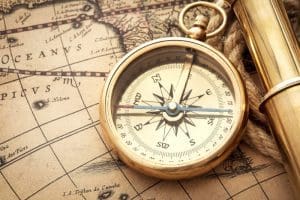 The first documented correlation between electricity and magnetism came from Gian Domenico Romagnosi, a 19th-century Italian legal scholar who noticed that a magnetized needle moved in the presence of a voltaic pile (the predecessor to a battery). Hans Christian Ørsted observed a similar occurrence in April 1820. He was setting up materials for an evening lecture and noticed that a compass needle changed directions when he connected a battery to a circuit. Neither Romagnosi nor Ørsted could explain the phenomenon, but they knew there was a defined relationship.
The first documented correlation between electricity and magnetism came from Gian Domenico Romagnosi, a 19th-century Italian legal scholar who noticed that a magnetized needle moved in the presence of a voltaic pile (the predecessor to a battery). Hans Christian Ørsted observed a similar occurrence in April 1820. He was setting up materials for an evening lecture and noticed that a compass needle changed directions when he connected a battery to a circuit. Neither Romagnosi nor Ørsted could explain the phenomenon, but they knew there was a defined relationship.
In 1873, James Clark Maxwell released a publication titled A Treatise on Electricity and Magnetism, which explained the presence of four effects:
- Electric charges attract or repel one another with a force inversely proportional to the square of the distance between them: Unlike charges attract, like ones repel.
- Magnetic poles (or states of polarization at individual points) attract or repel one another in a manner similar to positive and negative charges and always exist as pairs: Every north pole is yoked to a south pole.
- An electric current inside a wire creates a corresponding circumferential magnetic field outside the wire. Its direction (clockwise or counter-clockwise) depends on the direction of the current in the wire.
- A current is induced in a loop of wire when it is moved toward or away from a magnetic field, or a magnet is moved toward or away from it; the direction of current depends on that of the movement.
What Causes a Magnetic Field when Electricity Flows?
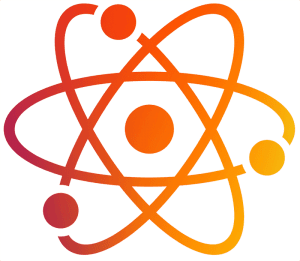 Electricity is the movement of electrons into and out of a conductor. One electron enters the end of a conductor, bumps into another electron, and so on until a different electron leaves the other end of the conductor and enters the load.
Electricity is the movement of electrons into and out of a conductor. One electron enters the end of a conductor, bumps into another electron, and so on until a different electron leaves the other end of the conductor and enters the load.
Because there are effectively more electrons in the conductor when current is flowing, the balance of negatively charged electrons to positively charged ions is upset and thus causes an imbalance in the magnetic field around the conductor.
We could devote thousands of words to explaining how atoms work. But in short, the core of an atom has a core of positively charged protons with a bunch of negatively charged electrons circling this core. When there is no flow of current, an atom doesn’t have a magnetic field because the quantity and path of the electrons around the protons are balanced. When we bump an electron out of an atom and into another, the atoms become imbalanced and thus produce a net magnetic field.
An Explanation On a Larger Scale
When electricity flows from the positive terminal of a battery to the negative, a magnetic field is created around the conductor. If you look at the image below, you will see the direction of the magnetic field relative to the flow of power.
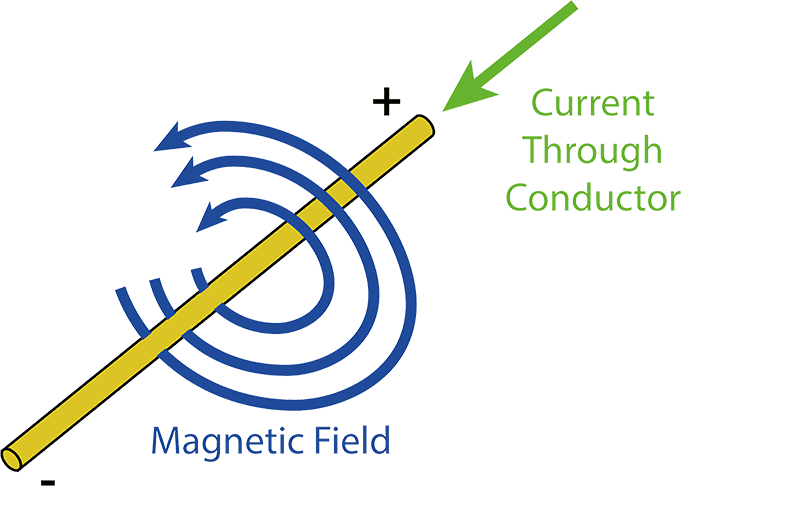
In schools, this is often referred to as the right-hand rule. If you wrap your right hand around a conductor with your thumb extended upward in the direction of current flow (putting positive below your hand and negative above), your fingers point in the direction of the magnetic field.
Keep in mind that for audio signals, the polarity of the current changes from positive to negative in the same way that the vibrations produced by someone talking or playing an instrument pressurize and rarefy the air to produce sound.
How Magnetism Makes a Speaker Work
Conventional moving coil loudspeakers use a coil of wire (called a voice coil) and a fixed magnet. The electricity from the amplifier flows through the voice coil and creates a magnetic field. The polarity of the magnetic field pulls the voice inward or pushes it out in an amount proportional to the strength of the magnetic field.
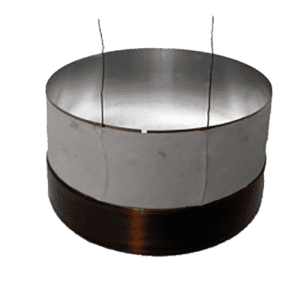
The diagram below shows the force exerted on the voice coil with the current flowing through the positive half of the audio waveform.
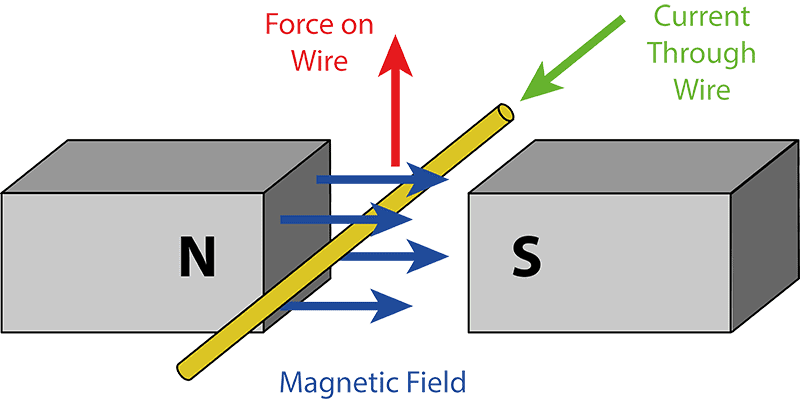
This diagram shows the force exerted on the voice coil with the current flowing through the negative half of the audio waveform.
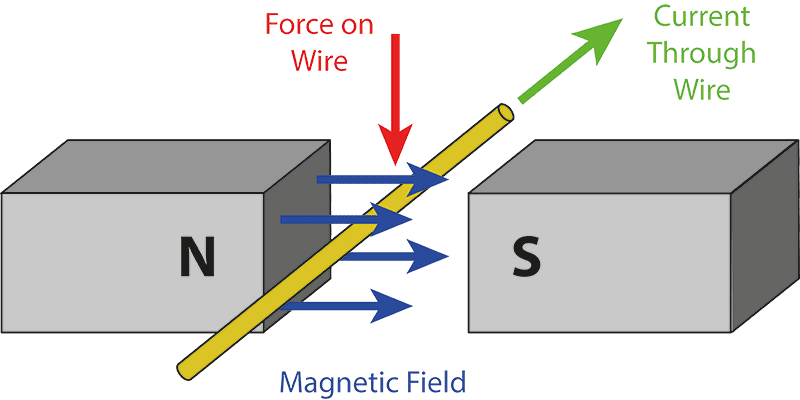
As the polarity of the current reverses, so too does the force exerted on the voice coil, which is attached to the speaker cone through the voice coil former.
Magnetism Isn’t Always Beneficial
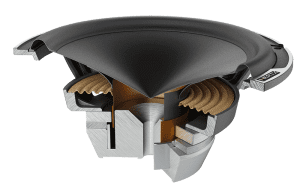 Regarding speakers, we rely on and need magnetic fields for them to work. With that said, magnetism doesn’t always work in our favor.
Regarding speakers, we rely on and need magnetic fields for them to work. With that said, magnetism doesn’t always work in our favor.
If there is a large amount of current flowing through a conductor, there will be a strong magnetic field around that conductor. If we place another conductor in that magnetic field, a voltage will be produced across the second piece of wire.
In our vehicles, many devices such as fans, sensors, the alternator, lighting control modules and computers create magnetic fields containing high-frequency noise. When an improperly shielded interconnect passes through one of these fields, it can pick up that noise and produce a voltage on the conductor. This phenomenon is why it’s important for your installer to run the interconnect cables and often the speaker wires in your car away from sources of electrical noise.
Consult Your Local Mobile Electronic Installation Experts
When it’s time to upgrade the sound system in your vehicle, visit your local specialized mobile enhancement retailer. They have the training and experience to ensure your new audio system will sound great and be free of unwanted noise!
In our next article, we are going to talk about inductance and capacitance and how those characteristics affect high-frequency electrical signals.
This article is written and produced by the team at www.BestCarAudio.com. Reproduction or use of any kind is prohibited without the express written permission of 1sixty8 media.
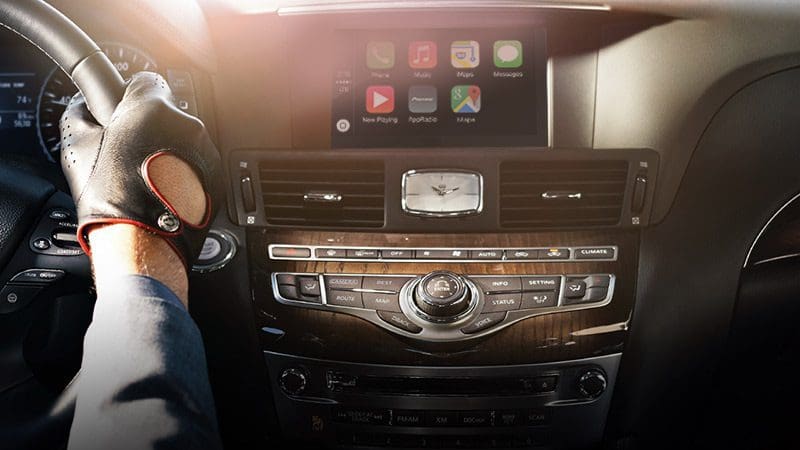 On Sept. 17, 2018, Apple launched iOS12 – its latest update to the operating
On Sept. 17, 2018, Apple launched iOS12 – its latest update to the operating 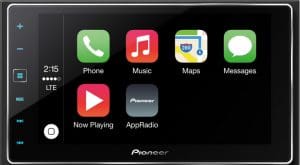 CarPlay is a smartphone integration technology designed to provide voice-command communication and entertainment features in our cars, trucks and SUVs. CarPlay is software that runs on your source unit and communicates with your smartphone to handle command requests, providing information on the screen of your radio and through your speakers.
CarPlay is a smartphone integration technology designed to provide voice-command communication and entertainment features in our cars, trucks and SUVs. CarPlay is software that runs on your source unit and communicates with your smartphone to handle command requests, providing information on the screen of your radio and through your speakers.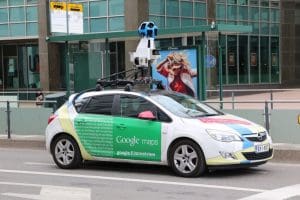 From the time CarPlay launched in September 2014 until September 2018, the only navigation option available was Apple Maps. Apple Maps originally debuted in 2012 and with it came criticism for its limited features and questionable accuracy. In 2015, Apple announced that it had a fleet of vehicles traveling the country to collect information similar to what Google offers in Street View.
From the time CarPlay launched in September 2014 until September 2018, the only navigation option available was Apple Maps. Apple Maps originally debuted in 2012 and with it came criticism for its limited features and questionable accuracy. In 2015, Apple announced that it had a fleet of vehicles traveling the country to collect information similar to what Google offers in Street View.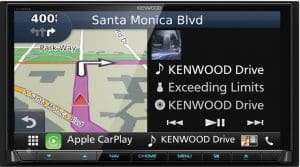 Finding a destination is very easy when navigating using
Finding a destination is very easy when navigating using  Google has invested billions of dollars in creating and maintaining its Google Maps product since purchasing a C++ computer program from the Sydney-based Where 2 technologies in October 2004. Shortly afterward, Google purchased a geospatial visualization company called Keyhole and a company called ZipDash that specialized in real-time traffic analysis. Google Maps officially launched in February 2005, and in October 2009, Google replaced Tele Atlas as its primary supplier of geospatial data with its own information. Google Maps as quickly become the de facto standard for smartphone navigation solutions.
Google has invested billions of dollars in creating and maintaining its Google Maps product since purchasing a C++ computer program from the Sydney-based Where 2 technologies in October 2004. Shortly afterward, Google purchased a geospatial visualization company called Keyhole and a company called ZipDash that specialized in real-time traffic analysis. Google Maps officially launched in February 2005, and in October 2009, Google replaced Tele Atlas as its primary supplier of geospatial data with its own information. Google Maps as quickly become the de facto standard for smartphone navigation solutions. As of September 2018, Apple CarPlay supports Google Maps as a
As of September 2018, Apple CarPlay supports Google Maps as a  Both Google Maps and Waze include dedicated voice recognition icons on the main screen. They use Google Assistant to handle the voice recognition features and report findings back to the respective software app.
Both Google Maps and Waze include dedicated voice recognition icons on the main screen. They use Google Assistant to handle the voice recognition features and report findings back to the respective software app.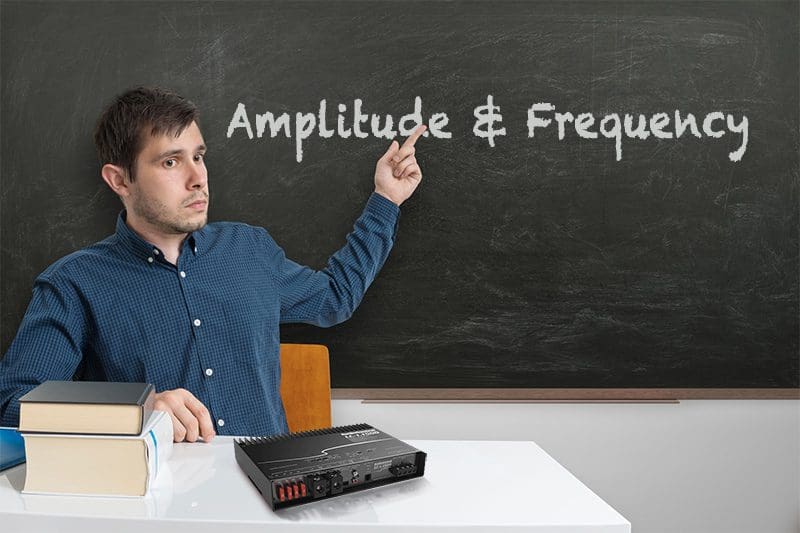 In our
In our 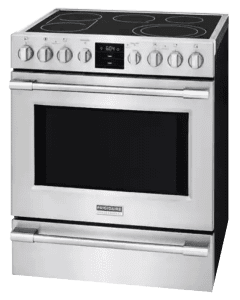 In a DC power source, the amplitude is fixed at a certain level. In our cars, this level is around 12 volts. In our homes, the voltage at the wall receptacle is 120V. High-power devices like an electric stove, a clothes dryer or an air conditioner are typically powered by 240V to reduce the amount of current required to make these devices operate.
In a DC power source, the amplitude is fixed at a certain level. In our cars, this level is around 12 volts. In our homes, the voltage at the wall receptacle is 120V. High-power devices like an electric stove, a clothes dryer or an air conditioner are typically powered by 240V to reduce the amount of current required to make these devices operate.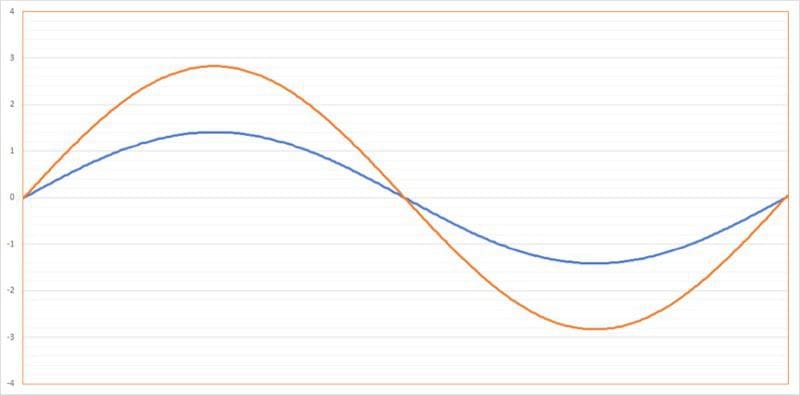 Just a reminder: The RMS value of a sine wave is 0.707 times its peak value. In the case of these waveforms, the peak values would be 1.414 and 2.818 volts.
Just a reminder: The RMS value of a sine wave is 0.707 times its peak value. In the case of these waveforms, the peak values would be 1.414 and 2.818 volts.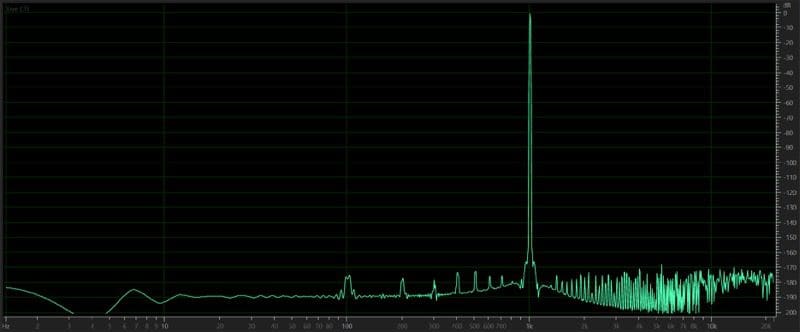 The “stuff” you see at the bottom of the screen is noise. Every signal contains some amount of noise. For this graph, we can see that the 1kHz signal is recorded at a level of 0dB and that the loudest noise component is almost 170dB quieter. This low amplitude makes the noise level irrelevant.
The “stuff” you see at the bottom of the screen is noise. Every signal contains some amount of noise. For this graph, we can see that the 1kHz signal is recorded at a level of 0dB and that the loudest noise component is almost 170dB quieter. This low amplitude makes the noise level irrelevant.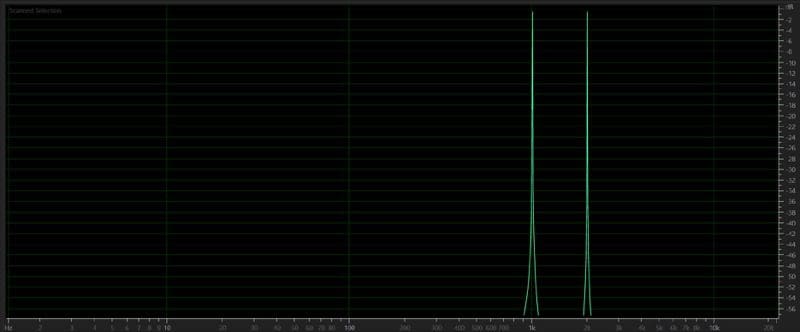 Almost every audio signal we hear comprises an infinite number of frequencies. The relative level of these frequencies is what makes one person’s voice sound different than another’s or makes a piano sound different than a guitar.
Almost every audio signal we hear comprises an infinite number of frequencies. The relative level of these frequencies is what makes one person’s voice sound different than another’s or makes a piano sound different than a guitar.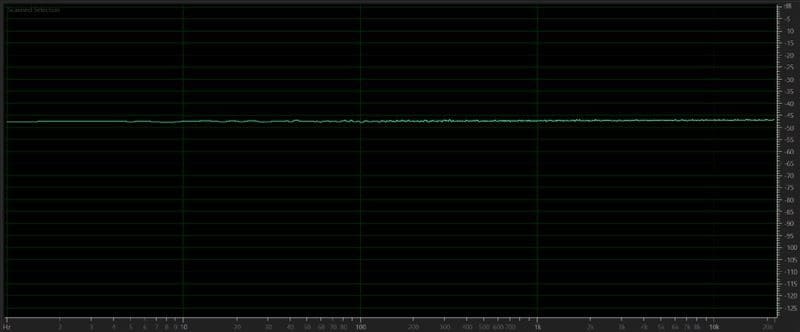 Another important signal is called pink noise. We use this signal when measuring the frequency response of a speaker. Unlike white noise that contains signals at equal levels at all frequencies, pink noise has an equal amount of signal energy per octave. When looked at in the frequency domain, the level decreases at a rate of 10dB per octave as frequency increases.
Another important signal is called pink noise. We use this signal when measuring the frequency response of a speaker. Unlike white noise that contains signals at equal levels at all frequencies, pink noise has an equal amount of signal energy per octave. When looked at in the frequency domain, the level decreases at a rate of 10dB per octave as frequency increases.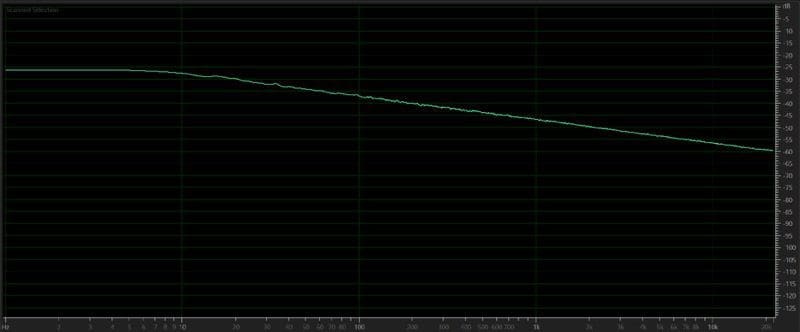 When you play pink noise through a set of
When you play pink noise through a set of  This frequency response graph shows us how much sound energy this speaker will produce when driven by a pink noise signal.
This frequency response graph shows us how much sound energy this speaker will produce when driven by a pink noise signal.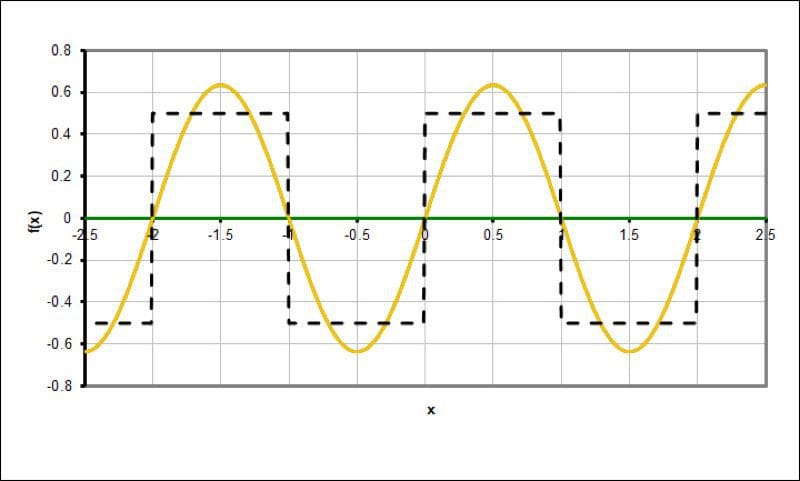 The yellow line shows a single sine wave with no harmonics.
The yellow line shows a single sine wave with no harmonics. The yellow waveform adds the third harmonic of the fundamental frequency.
The yellow waveform adds the third harmonic of the fundamental frequency.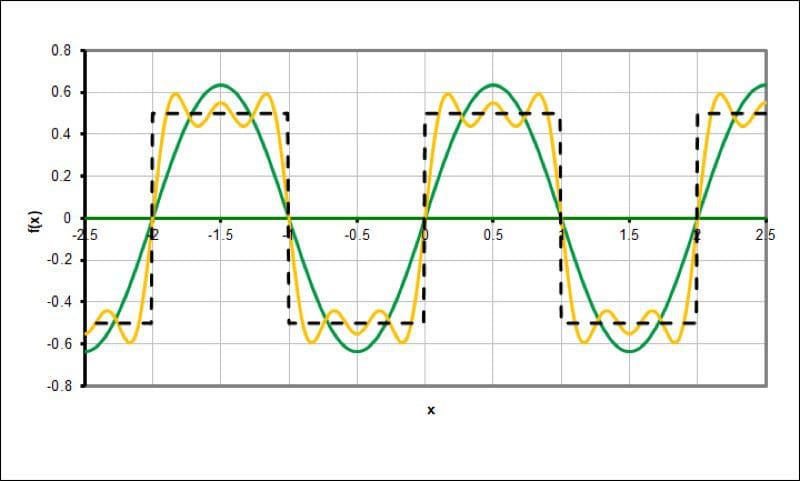 The yellow waveform adds the third and fifth harmonic of the fundamental frequency.
The yellow waveform adds the third and fifth harmonic of the fundamental frequency.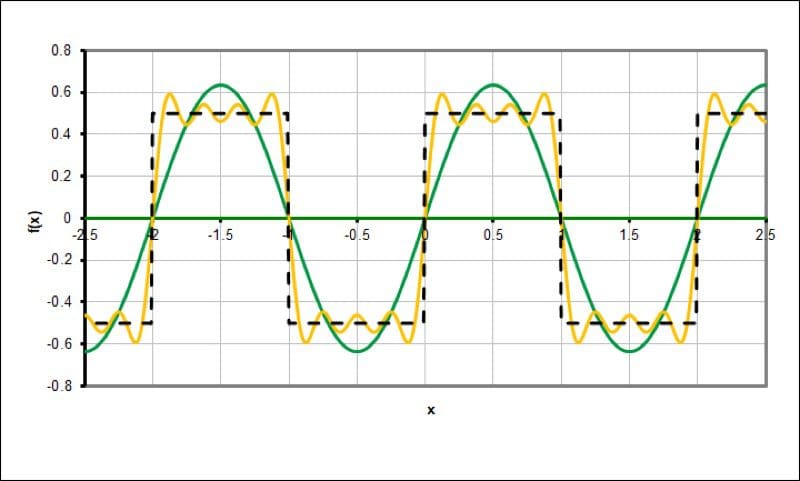 The yellow waveform adds the third, fifth and seventh harmonic of the fundamental frequency.
The yellow waveform adds the third, fifth and seventh harmonic of the fundamental frequency.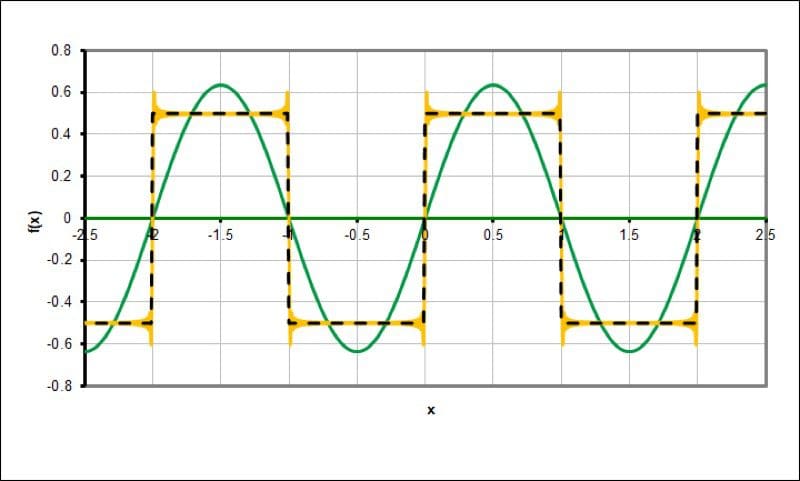 The yellow waveform shows the 100 odd-ordered harmonics as well as the fundamental frequency.
The yellow waveform shows the 100 odd-ordered harmonics as well as the fundamental frequency.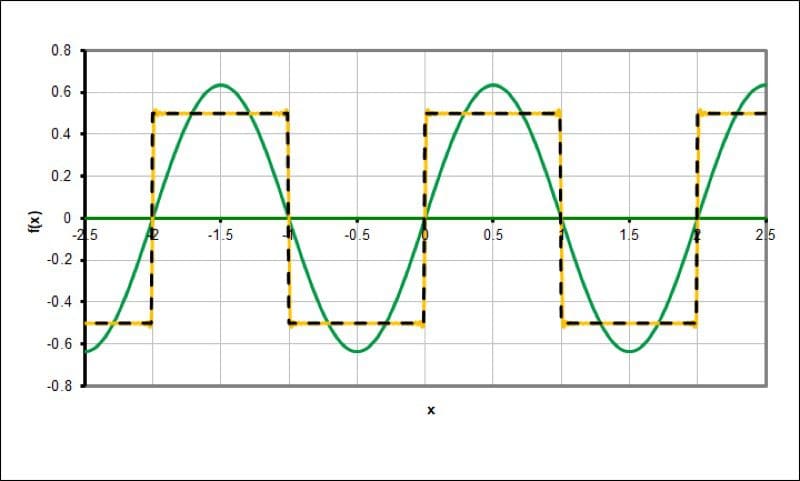 In this graph, we have the fundamental frequency and 256 odd-ordered harmonics added together.
In this graph, we have the fundamental frequency and 256 odd-ordered harmonics added together.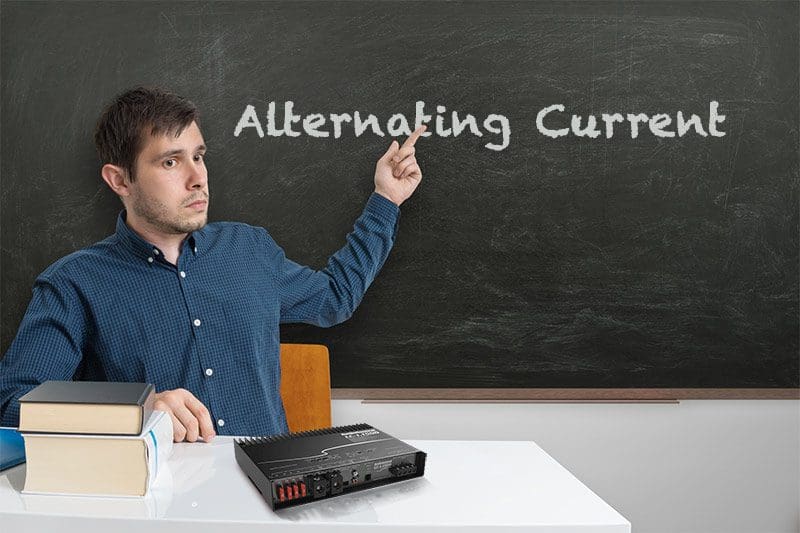 In our ongoing series of articles about
In our ongoing series of articles about 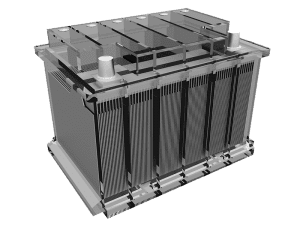 The voltage produced by the electrical system in our vehicles is called direct current. The electrons flow in one direction from one terminal of the battery to the other (except when we are recharging the battery). While there are changes in the voltage level as we add loads to the circuit, or when the alternator starts recharging the battery, the direction of current flow to the electric and electronic devices in the vehicle never changes.
The voltage produced by the electrical system in our vehicles is called direct current. The electrons flow in one direction from one terminal of the battery to the other (except when we are recharging the battery). While there are changes in the voltage level as we add loads to the circuit, or when the alternator starts recharging the battery, the direction of current flow to the electric and electronic devices in the vehicle never changes.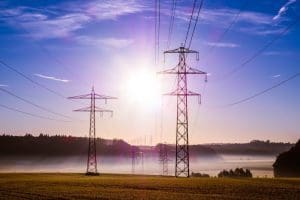 Researchers believe that the first electrical power source was a clay pot that contained tin plates and an iron rod. If filled with an acidic solution like vinegar, a voltage would be produced on the metal terminals. The belief is that this first battery was created more than 2,000 years ago. All batteries are direct current power sources.
Researchers believe that the first electrical power source was a clay pot that contained tin plates and an iron rod. If filled with an acidic solution like vinegar, a voltage would be produced on the metal terminals. The belief is that this first battery was created more than 2,000 years ago. All batteries are direct current power sources.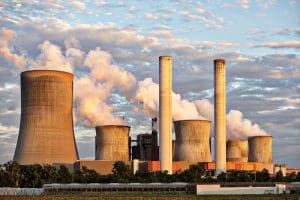 The output of a generator in a nuclear, coal or hydroelectric plant is 20 to 22 kilovolts. This voltage is stepped up to between 155,000 to 765,000 volts using a transformer for distribution around the state or province. Most of the high-voltage towers you see along the highway or in clearings have around 500,000 volts flowing through the three power conductors.
The output of a generator in a nuclear, coal or hydroelectric plant is 20 to 22 kilovolts. This voltage is stepped up to between 155,000 to 765,000 volts using a transformer for distribution around the state or province. Most of the high-voltage towers you see along the highway or in clearings have around 500,000 volts flowing through the three power conductors.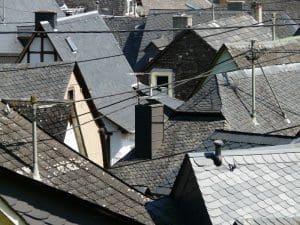 If we want 5,000 watts of power delivered through this mile of cable, there will be some energy lost to the resistance in the cable. If we transmit our power at 240 volts, there will be 20.83 amps of current flowing in the cable. With a resistance of 3.6 ohms, the cable itself causes a loss of 1562.5 and we lose 75 volts across the cable. Clearly, low-voltage signal transmission over long distances doesn’t work.
If we want 5,000 watts of power delivered through this mile of cable, there will be some energy lost to the resistance in the cable. If we transmit our power at 240 volts, there will be 20.83 amps of current flowing in the cable. With a resistance of 3.6 ohms, the cable itself causes a loss of 1562.5 and we lose 75 volts across the cable. Clearly, low-voltage signal transmission over long distances doesn’t work.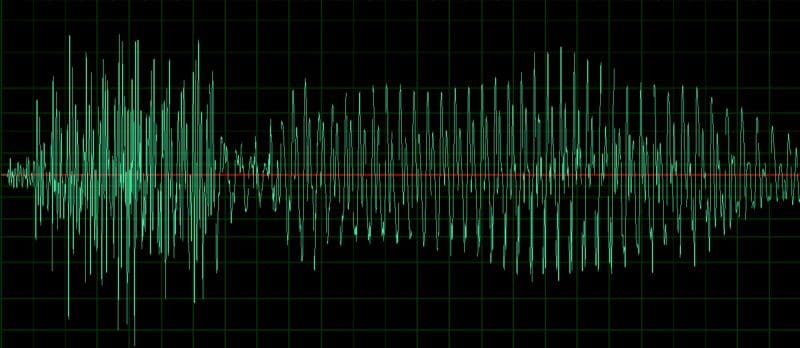
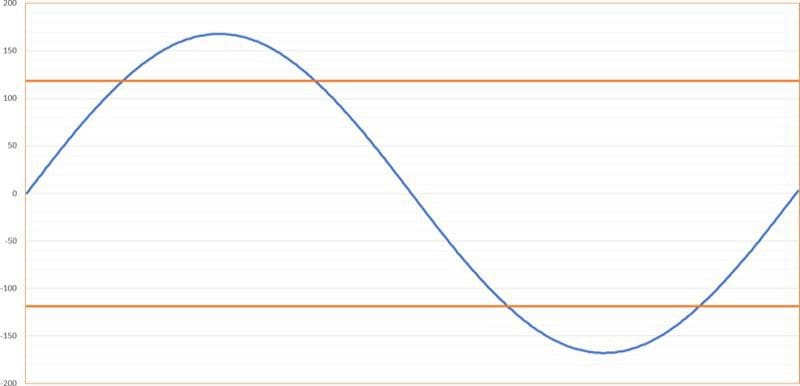
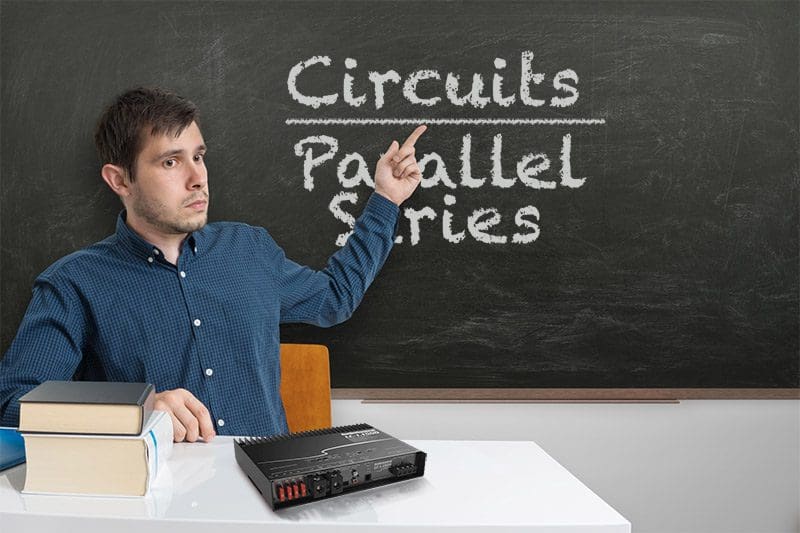 We’ll continue our introduction to the basics of car audio electrical theory by talking about wiring loads in series and parallel. Understanding the characteristics of each wiring option and how it relates to power delivery and current consumption is crucial in choosing the right
We’ll continue our introduction to the basics of car audio electrical theory by talking about wiring loads in series and parallel. Understanding the characteristics of each wiring option and how it relates to power delivery and current consumption is crucial in choosing the right 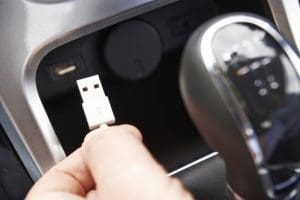 At this point, you should be familiar with the basic concept of wiring a load to a power source. In our cars, this could be something as simple as plugging a USB phone charger into the center console or having your installer integrate an
At this point, you should be familiar with the basic concept of wiring a load to a power source. In our cars, this could be something as simple as plugging a USB phone charger into the center console or having your installer integrate an 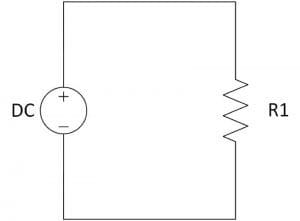
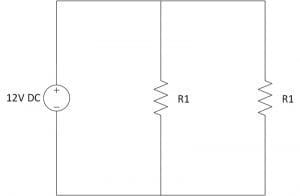



 Let’s use the example of an
Let’s use the example of an 